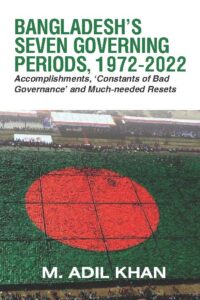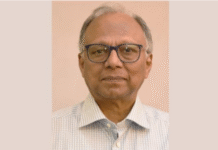Publisher and Distributed by South Asia Journal, New Jersey, USA (www.southasiajournal.net) ISBN: 978-0-9995649-9. If you would like to purchase, you can contact info@southasiajournal.net. USA US$ 28.00 India, Bangladesh, and Pakistan INR750.00
By Ghulam Suhrawardi 17 December 2023
Comprising ten chapters, the book sums up Bangladesh’s economic, political, and standing in the world, specifically in the immediate neighborhood of South Asia. Adil Khan tried to develop a compact study of a country that rose from a basket case (a term coined derogatorily by Kissinger during the country’s inception) to an engine of growth in the current period. It was a challenging episode from the chaotic beginning to cranking the growth engine in the late seventies. Then Bangladesh passed through a decade of autocratic rule by a cunning general (1982-1990) turned President who is allegedly complicit in terminating his predecessor through an orchestrated bloody army infighting. Democracy saw the day of light in 1991 after overthrowing the dictator.
Bangladesh passed bumps and rough rides through several episodes till landing in a period of national growth during the stewardship of a crafty politician who has engineered several elections, keeping the opposition at bay. Hasina is working very hard to destroy the main opposition, the Bangladesh Nationalist Party (BNP), to establish her authoritarian traits, yet calling it a democracy. Bangladesh’s multiparty democracy is being methodically strangled in crowded courtrooms across this country of 170 million people.
The book is a timely summary of the performance of ‘seven governing periods’ since independence in 1971. The first ten years were rocky, and one must be astute enough to comb through this period to make a fundamental and unbiased study of the leaders who steered the nation through the turmoil. This period saw two great leaders, Sheikh Mujibur Rahman and Ziaur Rahman, who set milestones in their capacity. They were true nationalists who set a course that zealots try to play one against the other. Both were killed in deceptive rebellions that, some believe, had mysterious international plots in which local zealots were utilized.
The second decade fell into the hands of a dictator, General Ershad, who had to be toppled in a powerful rally by the people. Ershad’s legacy still exists within a small population who benefited during his rule. Although a cultured person with a mellow demeanor, Ershad’s legacy of rampant corruption remains integral to some political leaders. Bangladesh has not evolved out of the stigma of corruption even to date. Instead, it has multiplied in propensity.
The school textbooks now reflect a version that suits the present AL regime. Many structures and posters throughout the country reflect one hero, the father of the current Prime Minister, Sheikh Mujibur Rahman. The school children are discouraged from learning about the other great heroes of Bangladesh.
Adil Khan aptly defines the seven periods for the readers who want to breeze through the political and economic development of the nation. As an economist, he has covered the unprecedented economic growth against the ‘Constants of Bad Governance’ (CoBGs) with data for easy understanding. Chapter 8 covers ‘development’ shoulder to shoulder with ‘underdevelopment’.
Hasina craftily coined ‘unnoyon’ and “muktijudder chetona” to prop up public opinion in favour of her regime and at the same time, stigmatizing the opposition as ‘non-chetona’ elements, devoid of the spirit of the liberation ideals.
Unnoyon means development, while muktijudder chetona implies the spirit of the liberation war 1971. The students in the schools must learn and recite these words daily. A college kid today has been brainwashed with a one-sided view of the liberation war and, in the process, is barred from knowing or understanding what the liberation war means and was fought for. Chetona or spirit covers your love for liberation, while the study about the real freedom fighters is avoided in the textbooks. Unnoyon or development gives the drum beats of Hasina’s Awami League. So, the education system gives all credit for the liberation war to the development of Bangladesh as the exclusive domain of her party, specifically her father, Sheikh Mujibur Rahman, and her family.
To denigrate the opposition, she coined the words “pro-liberation” and “anti-liberation” to differentiate between her party (Awami League) and supporters and opposition (Bangladesh Nationalist Party and Jamaat) and portray the two groups in a “good cop-bad cop” game. These slogans resonate well with the supporters and the young generation who have no idea about the background and the prosecution of the liberation war. School history books have been distorted to suit the ruling party, the Awami League. The book helps paint a more balanced picture of who’s who of Bangladesh, progress and otherwise.
The 2023 textbooks portray the Muslim rulers of Bengal as “outsiders” with favorable mentions of the Hindu and Buddhist kings. Sidelining and, in some cases, demonizing rich Islamic history is believed to resonate well with the ruling party’s chief foreign patron, India’s Modi government, and its Hindutva policy of demonizing India’s Muslim history in a planned manner.
Chapter 9 covers “One Step Forward, Two Steps Back,” which summarizes Bangladesh’s evolving pattern of progress and regression, covering terms of “Constants of Bad Governance (CoBG),” Which since 2009 have multiplied manifold. Khan covered the role of the NGOs in the development process, while Hasina denigrated some of their leaders with personal attacks. Nobel Laureate Professor Yunus, the founder of the Grameen Bank, received the brunt of her indecent adjectives with threats to put him in jail.
The backslides of democracy and human rights violations, rising inequality, and corruption as CoBGs had a rampant rise during the Hasina regime, which, like termites inside a building, are devouring the very foundations of the society and threatening to undo many remarkable accomplishments that Bangladesh achieved during the last five decades.
Currently, democracy in Bangladesh exists in terms of the political rhetoric of the ruling Awami League, where election engineering, repression of the opposition, and prosecution of dissenting voices have become more of a norm than an exception. The entire system of governance, i.e., the legislative, executive, and judiciary, has ceased functioning and converged into one person, the Prime Minister. Calling the system a “Westminster” type of democracy is not just a joke but an insult to the very idea of liberal democracy.
An estimated half of the five million prominent opposition party members, the Bangladesh Nationalist Party, have since been embroiled in politically motivated court cases. The most active leaders and organizers face dozens, even hundreds, of cases. Nearly every day, thousands of leaders, members, and supporters of opposition parties stand before a judge, defending themselves against false and politically motivated charges, in vain. Charges are usually vague, and evidence is shoddy, at best. All these happened just a month before the 12th parliamentary election on January 7, 2014.
Chapter 10 prescribes the “much-needed resets” for good governance, restoring democracy, and prosecuting a fair and participatory election system. Presently, Bangladesh can best be described as a hybrid democracy veering on fascism. The resets are a prescription to righting the decades of wrongs. Bangladeshis deserve a true democracy where they can festively discharge their right to select the next ruling party. We fought the liberation war to establish just that – to be governed through a freely elected government to preserve the rights and dignity of every citizen uncompromisingly.
The book is good for Bangladeshis and foreign readers interested in Bangladesh. The book also presents a critical message: citizens must play a more conscientious role and go beyond party loyalties to ensure that governments do not deviate from democratic means, norms, and practices and adhere to the basic tenets of human rights.
Despite some minor errors in the print settings, the book has been composed well for the avid reader who wants to grasp the political dynamics of Bangladesh quickly. And more importantly, in light of the present developments and, indeed, the looming crisis, the book is must-read.
While it is appreciated that the book focused on the post-independence governance of Bangladesh, it would have been good to include in the narratives the period of the government in exile in Kolkata in March-December 1971 under Tajuddin Ahmed and the role of the illustrious commanders and the soldiers who defected from the Pakistani army. Without their leadership and sacrifices, the liberation war would have lost its bearings. If Tajuddin continued as the Prime Minister with Mujib in a lofty Father of the Nation role without the role of the governing President, he probably would have been in a better position to guide and arbitrate, and perhaps it would be a different Bangladesh today.
Ghulam Suhrawardi is the Publisher of South Asia Journal. He can be reached at suhrawardi@southasiajournal.net










